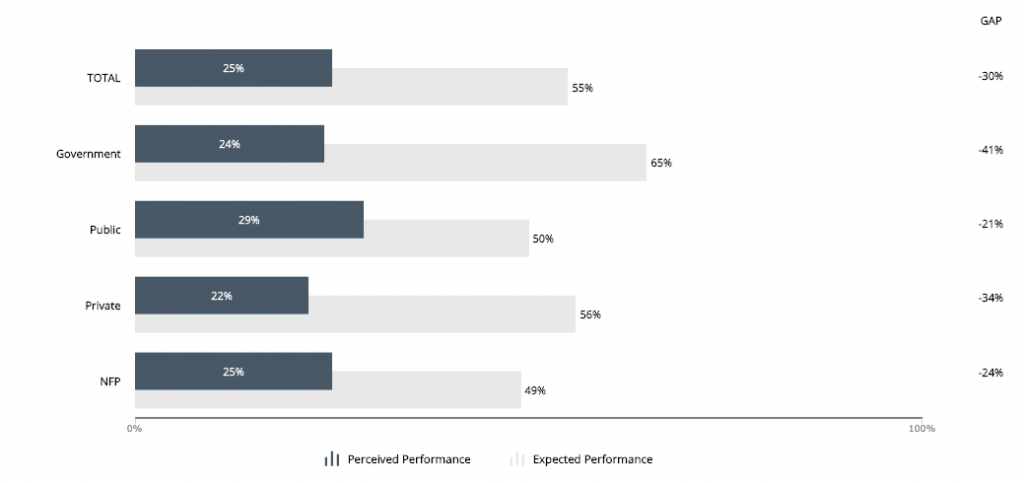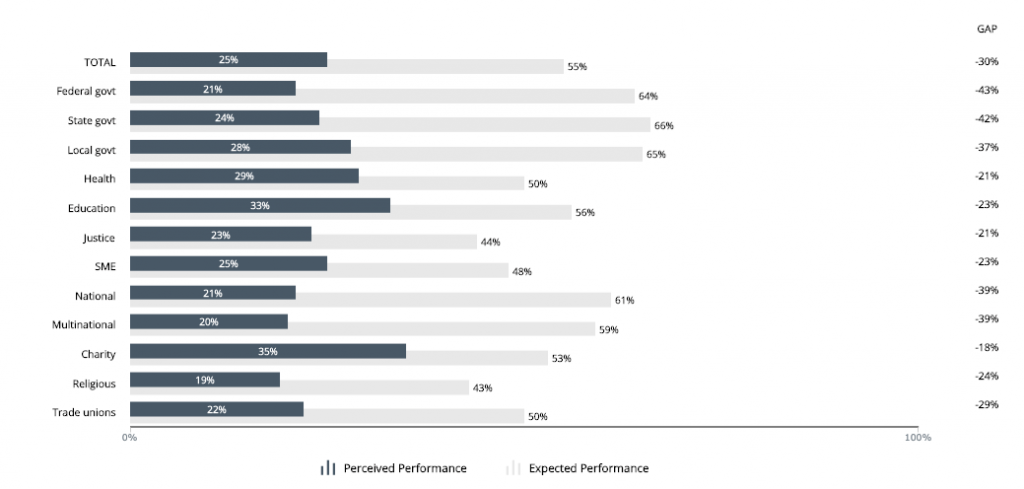Creating environmental value through leadership
The Australian Leadership Index (ALI) is a national survey that provides a comprehensive picture of perceptions of leadership for the greater good in the government, public, private and not-for-profit sectors.
The ALI model of institutional leadership for the greater good delineates three sets of indicators of leadership for the greater good that pertain to the type of value that institutions seek to create, how institutions create value, and for whom institutions create value.
For each of these indicators, we measure public perceptions and expectations. In addition to this, we calculate the relationship between perceptions of each indicator and overall perceptions of leadership for the greater good, yielding insights into the key drivers of public perceptions of leadership in the government, public, private, and not-for-profit sectors.
This note is part of a three-part series on the type of value that institutions seek to create. The focus of this note, the final in the series, is on leaders’ focus on the creation of environmental value, which the ALI defines as the creation of positive environmental outcomes (e.g., protecting the environment and improving environmental sustainability).
A note on the survey process
The results reported in this research note are the average of the results obtained from quarterly ALI surveys (1,000 people per quarter) between September 2018 and March 2020, which represents seven quarters of data collection.
Respondents are recruited via an online panel by Dynata and recruitment is designed to ensure that the sample is nationally representative in terms of locality (i.e., States and Territories), gender and age.
Results are analysed at the overall national level, as well as at the sector (i.e., government, public, private and not-for-profit sectors) and institution-level. ALI results can be further segmented according to a range of demographic variables. More information about the survey process can be found here and the ALI data portal can be found here.
Environmental value creation and leadership for the greater good
Recent years have witnessed growing, if uneven, concern about environmental sustainability and the need to address actually existing unsustainability. In the business domain, this is concern is reflected in concepts such as the triple bottom line and corporate social responsibility. This concern about environmental responsibility and environmental stewardship is reflected in the burgeeoning literature on leadership for environmental sustainability and regenerative and restorative leadership.
What role do perceptions of leaders’ focus on creating environmental value play in public perceptions of leadership for the greater good in the government, public, private and not-for-profit sectors?
Research by the Australian Leadership Index suggests that the answer depends to some degree on the sector under consideration.
ALI research reveals that public perceptions of leaders’ focus on creating positive environmental outcomes is a strong predictor of leadership for the greater good in the private sector. This means that the more leaders in the business sector appear to focus on the creation of environmental value, the more they are perceived to show leadership for the greater good.
By contrast, public perceptions of leaders’ focus on creating environmental value is a modest predictor of leadership for the greater good in the not-for-profit and public sectors and a weak predictor of leadership for the greater good in the government sector.
In sum, with a notable exception in the government sector, the degree to which leaders and their institutions are seen to care about and focus on creating positive environmental outcomes, the more they are judged to show leadership for the greater good.
Environmental value creation at the sector level
Having established the relationship between environmental value creation and leadership for the greater good, it’s pertinent to consider what ALI reveals about public perceptions and expectations of economic value creation in the government, public and not-for-profit sectors.
The public have moderate expectations of the degree to which institutions in the public, private and not-for-profit sectors should focus on creating environmental value. Roughly half of respondents think public and not-for-profit sector institutions should focus on creating economic value to a “fairly large” or “extremely large” extent.
By contrast, the public have high expectations of the degree to which government institutions should focus on creating environmental value. Roughly two-thirds of respondents think government institutions should focus on creating environmental value to a “fairly large” or “extremely large” extent.
The public sector is regarded as the strongest performer in terms of focus on environmental value creation, with 29% of respondents judging the public sector to focus on creating environmental value to “fairly large” or “extremely large” extent. This sector also has the second lowest expected focus on the creation of social value (50%). As a result, the public sector has the smallest gap between expectations and perceptions.
The private sector is seen the weakest performer in terms of focus on environmental creation, with 22% of respondents judging that this sector focuses on the creation of environmental value to “fairly large” or “extremely large” extent, with 56% expecting the private sector to focus on environmental value creation.
The government sector is associated with the biggest perception-expectation gap (a 41 percentage points), which is attributable to low perceived performance (24%) and high expectations (65%) on this criterion.

Figure 1. Perceived and expected focus on environmental value creation, sector-level, Sept. 2018-March 2020
Explore this data for yourself via the ALI custom chart builder.
Environmental value creation at the institution-level
Charities are regarded as the strongest performer in terms of focus on creating environmental value, with 35% of respondents judging that charities focus on the creation of environmental value to “fairly large” or “extremely large” extent. Charities also have the smallest perception-expectation gap (18 percentage points gap).
Religious institutions are seen the weakest performer, with only 19% of respondents judging that them to focus on creating environmental value to “fairly large” or “extremely large” extent.
The Federal Government has the biggest gap between public perceptions and expectations (43 percentage points), followed closely by State Governments (42 percentage point gap).

Figure 2. Perceived and expected focus on environmental value creation, institution-level, Sept. 2018-March 2020
Explore this data for yourself via the ALI custom chart builder.




